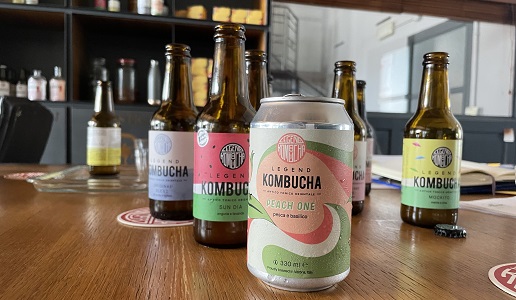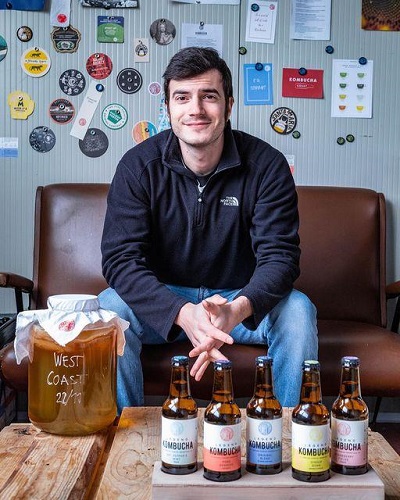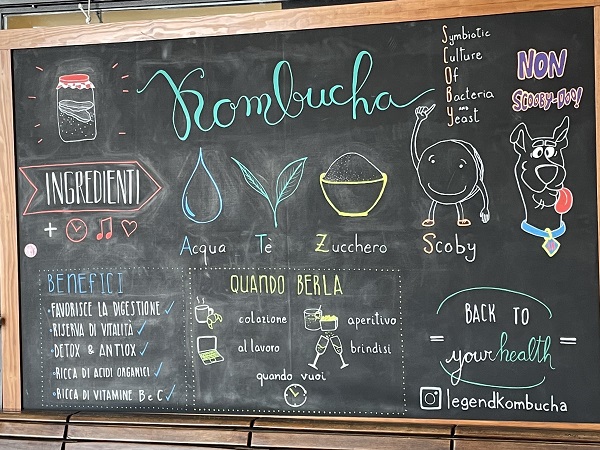Kombucha, the viable alternative with “super powers”

From millennia-old origins, artisanal, antioxidant, rich in organic acids, detox, gluten-free, low-calorie, vegan, non-alcoholic, digestive, vitality reserve... practically an elixir of long life, that's Kombucha!
Now all the rage, drunk by Hollywood stars such as Lady Gaga and popular personalities such as Kim Kardashian, let's not forget that it was also featured in a song by Renato Carosone who called it "stu fungo cinese." To find out what this drink, the panacea for all ills, is, I paid a visit to those who produce it. I went to see Stefano Zamboni, class of 1990 with a degree in Marketing and Communication from the University of Verona and founder of Legend Kombucha. A start-up that was born in 2018 following a trip to the Americas that led Stefano to change his life and make the production of Kombucha not only an art but above all a way of life. But, esteem for this young entrepreneur aside, which I may tell you more about later, let's get back to our Kombucha, what it is and how it is produced.

Kombucha originated more than 2,000 years ago, and the first records, in 221 B.C., about this natural tonic come from China, where it was consumed by Emperor Qin Shi himself. This is not surprising since it is a refermented tea-based beverage. In fact, Kombucha falls squarely into the category of superfoods, those that are fermented. To understand what makes it so valuable and what contributes to making it "super," we need to take a step back and ask why historically certain foods are fermented.
Fermentation of foods originates for two main reasons:
the first has to do with the preservation capacity of the food itself, which, compared to the fresh product, once fermented, naturally remains healthier and more suitable for consumption for longer.
The second concerns "the magic" (which is then all chemical) that takes place at the nutritional level. In fact, a fermented food amplifies its nutritional properties since, thanks to fermentation, the elements it contains become more available and assimilable by our bodies. Thus filling real needs for nutrient supplementation.
This is why fermented foods are considered superfoods. We can therefore imagine yogurt and kefir as "milk with muscles," and tempeh as "soybean sprouts that have worked out." As with all fermented foods, Kombucha is also no exception by involving only a few simple ingredients in its natural process. The process of making Kombucha should be considered natural, although it is expertly guided toward its successful production. This drink must be good for you yes but, thank God, it must also taste good! (fan fact: the yeasts responsible for alcoholic fermentation are Brettanomyces...)
It all starts with a few simple ingredients. The recipe calls for: water, tea, sugar and scoby (which works on the same principle as sourdough). The deus ex machina is indeed, pronounced as it is spelled, S - C - O - B - I, which stands for: symbiotic culture of bacteria and yeast. Indeed, responsible for the super powers of this drink is the symbiotic fermentation between yeast and bacteria. Specifically, yeasts ferment sugar (in the case of Legend Kombucha at the moment it is cane sugar) producing ethanol, which in turn is processed by bacteria that transform it into organic acids. This makes the drink non-alcoholic by law, as the traces of alcohol are between 0.5 and 1 percent, and rich in antioxidants from the fermentation activity. To conclude, the kombucha is bottled and there a second fermentation kicks off, the extent of which varies depending on the taste you want to give the drink and the amount therefore of sugars naturally present, those with fruit tend to have a higher effervescence. Here, then, the digestive properties of Kombucha are intensified thanks to the natural effervescence that develops in the bottle. Legend Kombucha's plans for the future include autoclave refermentation to optimize the production process.
Bottle-fermented or autoclaved Kombucha is always a raw, unfiltered or pasteurized product. Considered "alive," it has an expiration date; in fact, it is preferable to always consume it within the terms indicated on the bottle, but above all, it should be stored in the refrigerator to avoid unwanted fermentation restarts or, even worse, bottle bursts...even more unwanted!

Today Legend Kombucha, at its new location in the Verona area, produces about 30,000 bottles a year in the small, adorable 250 ml format (also available for purchase online). However, the production potential is almost endless and there is no shortage of demand, just as there is no shortage of new products on the way. "Sharing" formats of 0.50 and 0.750 l, as well as the 0.33 can. All in three basic flavors available year-round and certified organic, Original Blend, SGT. Pepper Mint and Ginger Bomb, and a series of seasonal flavors such as Sun Dia, watermelon and lavender that also carries out a project to enhance local businesses by sourcing raw materials from Go Go Fresh (Watermelons of Verona), or Strawberry Fields with strawberry, lime and hibiscus. Just to name a few, full range easily available online.
At this point it is fair to ask: what does it taste like? Kombucha is an extremely thirst-quenching drink, the taste tends to be acidic, the perception is more or less intense depending on the aroma that determines the taste. It is good consumed on its own, but it can be mixed, it is advisable to turn the bottle upside down before uncorking it, all gently respecting its effervescence. If we want to find a downside to it, we can say that it is non-alcoholic--and we, passionate wine drinkers, what do we care about a non-alcoholic drink? It can interest us as a viable alternative to our beloved wine. Not replacing it, that's for sure.
Another question I soon had answered concerns the caffeine content. It does indeed contain some but you will be pleased to know that per 100 ml we have 4 to 8 mg of caffeine, compared with 20 to 40 contained in 100 ml of tea and 60 to 90 contained in a cup of espresso.
Kombucha is not only liked by me, Lady Gaga and Kim Kardashian (which would also be the only thing we have in common), but it is also of great interest to the world of research and experimentation. So much so that Stefano Zamboni now boasts a preferential channel of communication with the University of Verona with regard to both the course in Enology and Viticulture and the department of Biotechnology.
There would be much more to say, but we will stop here for now. Hoping that the tale of this ancient oriental tonic has awakened some memories for you or intrigued you to learn more about it to the point of tasting it for the first time.

 Italiano
Italiano






